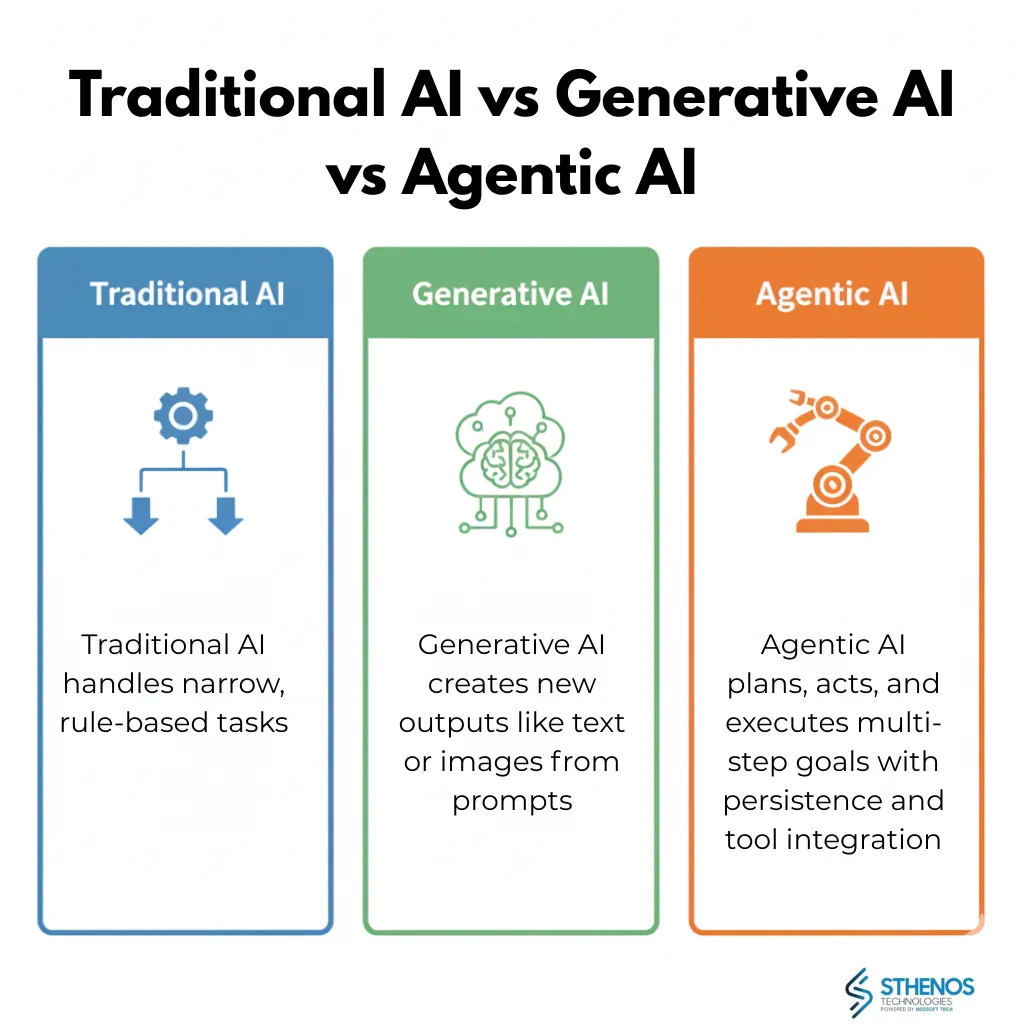Artificial intelligence has developed in stages, each with distinct capabilities. Traditional systems focused on narrow, rule-driven tasks. Generative models added creativity by producing text, code, and images. Agentic approaches move further, with systems capable of taking initiative, remembering context, and coordinating actions across tools. Understanding how these three differ is essential for organizations deciding where to invest and how to apply them.
In short, Agentic AI differs from generative and traditional AI in autonomy and goal pursuit. Traditional AI handles narrow, rule-based tasks; generative AI creates new outputs like text or images from prompts; agentic AI plans, acts, and executes multi-step goals with persistence and tool integration.
Let’s explain each of these systems in detail.

What is Traditional AI?
Traditional AI, sometimes referred to as narrow AI, is built to solve specific problems within strict boundaries. These systems rely on algorithms that classify, predict, or optimize based on historical data. They are excellent at repetitive, data-intensive work such as fraud detection, demand forecasting, or recommendation engines.
The strength of traditional AI lies in precision and reliability. A model trained to detect fraudulent credit card transactions can evaluate thousands of transactions per second with high accuracy.
The limitation is that these systems cannot transfer their knowledge beyond the problem they were designed. A fraud detection system cannot suddenly analyze medical scans without being retrained on an entirely new dataset.
What is Generative AI?
Generative AI introduced a new dimension by learning patterns in large datasets and using those patterns to create new material. Instead of just labeling or predicting, these systems generate original outputs such as text, images, or code.
A practical example is a marketing team using a generative model to produce hundreds of product descriptions in seconds. The value lies in flexibility and speed of content creation. However, generative systems do not maintain memory or goals. Each prompt is treated as a one-off task. While they can produce human-like responses, they do not plan multi-step processes or evaluate the impact of their outputs without human oversight.
What is Agentic AI?
Agentic AI, aka applied AI, represents a further progression. Instead of responding only when prompted, agentic systems can set objectives, plan steps, and carry them out across different environments. They combine reasoning, memory, and the ability to act through external tools.
For instance, an agentic IT system can detect a server failure, reroute workloads to another server, apply a patch, and then confirm stability. Unlike generative models that produce text or code, agentic systems persist until the task is complete. This autonomy offers major productivity gains but also raises questions of control, safety, and accountability.
Key Differences in a Comparative Table
| Aspect | Traditional AI | Generative AI | Agentic AI |
| Core Function | Classifies, predicts, or optimizes | Produces new content such as text, images, code | Pursues goals, plans steps, and executes tasks |
| Initiative | Operates only within set inputs | Responds to prompts | Acts proactively and independently |
| Memory | No persistence beyond single task | No persistence beyond single prompt | Maintains memory across interactions |
| Goal Orientation | Limited to task-specific outcomes | One-off creative outputs | Multi-step, goal-driven execution |
| Integration | Outputs insights for human or system use | Produces content, human must act on it | Integrates with tools and APIs to act directly |
| Adaptability | Requires retraining for new tasks | Adapts to prompts but not autonomous | Adjusts strategies in real time with feedback |
| Examples | Spam filters, fraud detection, forecasting | Marketing content, code generation, image design | IT automation, supply chain optimization, agents in customer service |
Read More: Multi-Agent Systems in AI: The Future of Distributed Intelligence
Use Cases in Practice
Traditional AI has been widely adopted in financial services, healthcare, and retail. Fraud detection systems block millions of suspicious transactions every day. Predictive maintenance models in manufacturing extend the life of machinery by analyzing sensor data and predicting breakdowns before they happen.
Generative AI has taken hold in industries where creativity and communication are vital. Marketing teams generate campaign material faster. Developers use code generation assistants to build prototypes. Designers employ image generation for quick iterations. These applications save time but still depend on human review for accuracy and alignment with strategy.
Agentic AI is beginning to show its value in environments where repetitive, multi-step tasks slow down human workers. In IT operations, autonomous systems identify an outage, initiate recovery processes, and escalate only when necessary. In supply chain management, agentic systems evaluate vendor quotes, negotiate orders, and update inventory systems. In customer support, they not only answer queries but also trigger account changes or schedule appointments.
Strengths and Limitations
Traditional AI offers stability and accuracy, but cannot adapt to tasks outside its training. Generative AI brings flexibility and creative variety but often produces outputs that require verification. Agentic AI can handle complex workflows without constant supervision, but it introduces greater risks if governance and oversight are not in place.
Research firms estimate that more than 40% of early agentic projects may be abandoned by 2027 because organizations underestimate the complexity of deploying autonomous systems. This highlights the need for careful integration and strong monitoring when adopting agentic approaches.
How to Decide Which One to Use
Organizations should match the type of system to the task. Traditional AI is best for structured, repetitive, and regulated domains where precision matters most. Generative AI is suited for rapid creation of content, design, or code where variety is valuable. Agentic AI should be considered when multi-step processes consume significant time and when automation can safely carry out tasks end-to-end.
The strongest strategies often combine them. A supply chain solution might use traditional AI for demand forecasting, generative AI to draft vendor communication, and an agentic system to execute procurement and logistics steps. This layered approach uses each system for what it does best.
How Sthenos Can Help
Sthenos partners with small and mid-sized enterprises to design and deploy agentic AI services that move beyond experimentation into measurable business outcomes.
Our team specializes in creating autonomous systems that integrate with your existing infrastructure, handle repetitive workflows, and deliver proactive decision-making.
From IT operations that self-heal to customer service agents that resolve issues end-to-end, Sthenos ensures that agentic AI adoption is safe, scalable, and tailored to real business needs.
By combining deep technical expertise with governance frameworks, we help organizations capture the full value of autonomy without compromising security or control.
Ready to Explore Agentic AI for Your Business? Schedule a Free Consultation to learn how our team can design safe, scalable, and tailored agentic AI solutions for your business.
The Future of AI
Agentic AI will likely drive the next wave of enterprise adoption, especially in industries where process automation and efficiency gains directly impact revenue.
Multi-agent systems, where different agents collaborate to complete entire workflows, are already under development. At the same time, regulatory bodies are preparing governance frameworks to address accountability and safety in autonomous systems.
Generative AI will continue to evolve, with models that integrate more context awareness and domain-specific knowledge. Traditional AI will remain a backbone for high-precision, narrow tasks.
Rather than replacing each other, the three approaches are expected to converge into hybrid systems, each playing a complementary role.
The Bottom Line
The distinctions between traditional, generative, and agentic AI determine what problems they can solve effectively. Traditional AI provides reliability for specific, well-defined tasks. Generative AI enables scalable creativity. Agentic AI extends intelligence into autonomy, allowing systems to plan, act, and adapt.
Choosing the right approach depends on the problem at hand. The most successful organizations will not treat these categories as competing, but as complementary layers that, when combined, deliver efficiency, creativity, and autonomy in balance.


